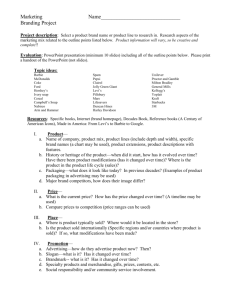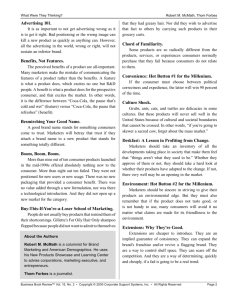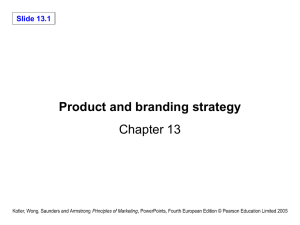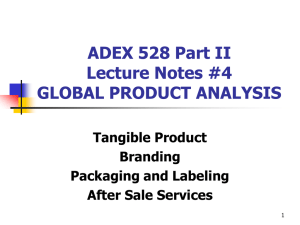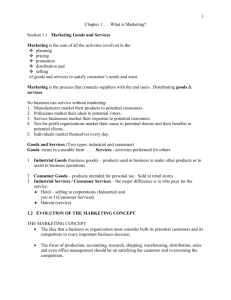Chapter 1 test
advertisement
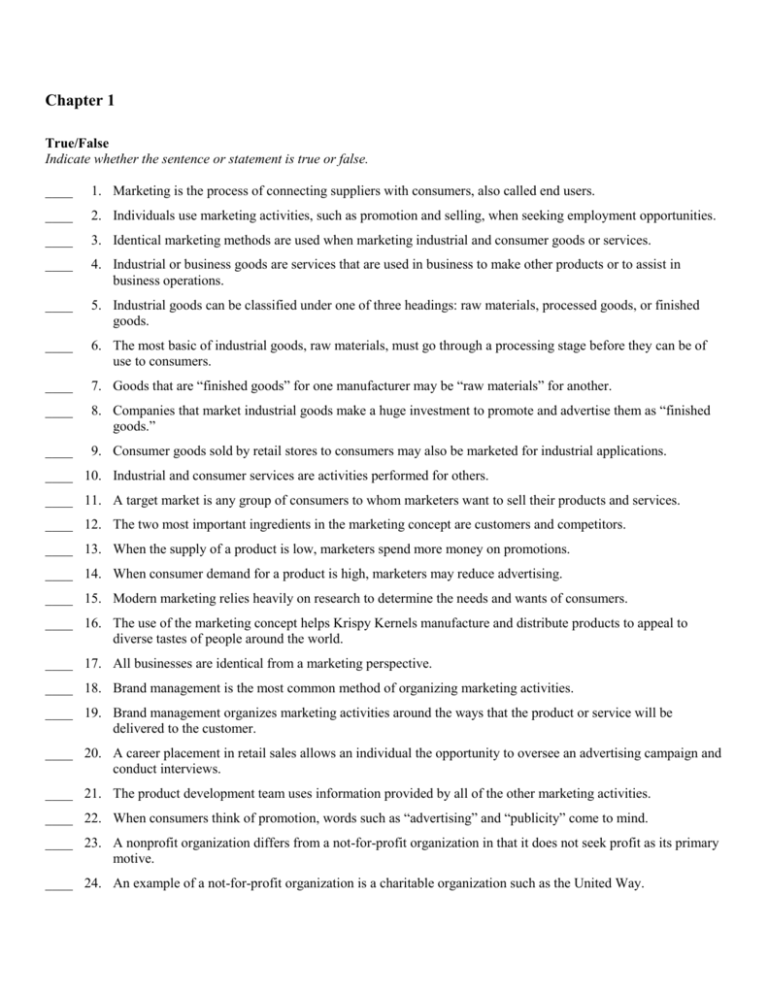
Chapter 1 True/False Indicate whether the sentence or statement is true or false. ____ 1. Marketing is the process of connecting suppliers with consumers, also called end users. ____ 2. Individuals use marketing activities, such as promotion and selling, when seeking employment opportunities. ____ 3. Identical marketing methods are used when marketing industrial and consumer goods or services. ____ 4. Industrial or business goods are services that are used in business to make other products or to assist in business operations. ____ 5. Industrial goods can be classified under one of three headings: raw materials, processed goods, or finished goods. ____ 6. The most basic of industrial goods, raw materials, must go through a processing stage before they can be of use to consumers. ____ 7. Goods that are “finished goods” for one manufacturer may be “raw materials” for another. ____ 8. Companies that market industrial goods make a huge investment to promote and advertise them as “finished goods.” ____ 9. Consumer goods sold by retail stores to consumers may also be marketed for industrial applications. ____ 10. Industrial and consumer services are activities performed for others. ____ 11. A target market is any group of consumers to whom marketers want to sell their products and services. ____ 12. The two most important ingredients in the marketing concept are customers and competitors. ____ 13. When the supply of a product is low, marketers spend more money on promotions. ____ 14. When consumer demand for a product is high, marketers may reduce advertising. ____ 15. Modern marketing relies heavily on research to determine the needs and wants of consumers. ____ 16. The use of the marketing concept helps Krispy Kernels manufacture and distribute products to appeal to diverse tastes of people around the world. ____ 17. All businesses are identical from a marketing perspective. ____ 18. Brand management is the most common method of organizing marketing activities. ____ 19. Brand management organizes marketing activities around the ways that the product or service will be delivered to the customer. ____ 20. A career placement in retail sales allows an individual the opportunity to oversee an advertising campaign and conduct interviews. ____ 21. The product development team uses information provided by all of the other marketing activities. ____ 22. When consumers think of promotion, words such as “advertising” and “publicity” come to mind. ____ 23. A nonprofit organization differs from a not-for-profit organization in that it does not seek profit as its primary motive. ____ 24. An example of a not-for-profit organization is a charitable organization such as the United Way. ____ 25. The consumer market, from a marketing perspective, consists of both current and future consumers. ____ 26. In marketing terminology, an “aggregate market” mean the same thing as a “differentiated market.” ____ 27. If a business is equipped to provide its customers with online service, it is sometimes called a B2B operation. ____ 28. The marketing mix of a business is sometimes called the four Ps of marketing. ____ 29. The promotion mix in marketing consists of research, product development, packaging, and branding. ____ 30. The four Cs of marketing are a customer-oriented way of viewing the four Ps of marketing. ____ 31. A marketing strategy outlines how a company will carry out the marketing plan. ____ 32. The primary goal of any distribution strategy is to communicate the value of the product or service to the consumer. ____ 33. A value equation is a marketing technique that matches positive concepts, such as benefits, with negative concepts, such as costs. ____ 34. The pull strategy sells a product to retailers, importers, or wholesalers, and not to the final consumers. ____ 35. Push and pull strategies can be used together in the distribution of products; however, the pull strategy can stand alone. Multiple Choice Identify the letter of the choice that best completes the statement or answers the question. ____ 36. To satisfy consumers’ needs and wants, marketers engage in activities such as a. planning c. selling b. distributing d. all of the above ____ 37. Nonindustrial goods intended for personal use by the general public are called a. consumer goods c. production goods b. industrial goods d. goods-in-process ____ 38. When goods are altered during production, they are going though a a. raw materials stage c. finished goods stage b. processing stage d. all of the above ____ 39. When marketing industrial finished goods, which one of the following is critical? a. personal contact c. special promotions b. advertising d. planning ____ 40. A company that cleans the offices of a bank after hours is an example of a(n) a. industrial good c. consumer good b. consumer service d. industrial service ____ 41. A skateboard sold by a local specialty shop is an example of a(n) a. industrial good c. consumer good b. consumer service d. industrial service ____ 42. A business that focuses on satisfying customers and overcoming competition is adhering to the a. marketing mix c. marketing concept b. marketing goals d. marketing services ____ 43. Marketing is redundant when a. consumer demand is low c. consumer demand is unknown b. consumer demand is high d. all of the above ____ 44. Which time period is most closely associated with the marketing philosophy, “Whatever we make, you’ll buy”? a. today c. 1900–1945 b. before 1900 d. 1945–1970 ____ 45. Krispy Kernels uses marketing and production techniques for success, such as a. convenient packaging c. global marketing b. peanut-free product line d. all of the above ____ 46. If a company sets up marketing and/or distribution centres in foreign countries, its organizational approach is a. distribution c. regional b. international d. brand ____ 47. If a company sets up marketing and/or distribution centres within a group of provinces, its organizational approach is a. regional c. distribution b. international d. brand ____ 48. A marketing career for people who work directly with consumers is a. marketing manager c. public accountant b. public relations manager d. retail sales personnel ____ 49. The marketing activity that deals with logos, slogans, and trademarks is a. storage c. packaging b. research d. branding ____ 50. The marketing activity that gathers consumer information through surveys is a. research c. labelling b. packaging d. promoting ____ 51. The marketing activity that ensures that the right quantity of goods is available for sale is a. storage c. product development b. inventory management d. physical distribution ____ 52. Which of the following types of organization best describes a charitable organization? a. not-for-profit c. nonprofit b. for-profit d. corporation ____ 53. The expression that best describes the market that consists of all consumers is a. target market c. differentiated market b. competitive market d. aggregate market ____ 54. The term that describes dealings between one business and another using online services such as the Internet is a. B2C c. ABC b. B2B d. B2D ____ 55. The marketing mix category that describes distribution, storage, and channel selection is a. product mix c. promotion mix b. place mix d. pricing mix ____ 56. The marketing mix category that describes research, packaging, and branding is a. product mix c. promotion mix b. place mix d. pricing mix ____ 57. Which one of the following outlines how a company will carry out its plan? a. marketing mix c. marketing objectives b. marketing goals d. marketing strategy ____ 58. Which one of the following must be included when creating a value equation? a. benefits c. promotion b. product d. place ____ 59. Which distribution strategy does not focus on selling products to the end user? a. push strategy c. a and b b. pull strategy d. target strategy ____ 60. Which distribution strategy is the one that most consumers think of when they think of marketing? a. push strategy c. mix strategy b. pull strategy d. target strategy Matching Match each of the following terms or expressions with the most accurate definition or description: a. not-for-profit organization f. nonprofit organization b. promotion activities g. consumer services c. industrial services h. branding terms d. low demand i. high demand e. brand channels j. distribution channels ____ ____ ____ ____ ____ ____ ____ ____ ____ ____ 61. 62. 63. 64. 65. 66. 67. 68. 69. 70. Something of value purchased by a business. Something of value purchased by individuals. An organization that uses surplus funds to improve services. Logo, slogan, and trademark. Vending machines, restaurants, and retail stores. Extensive marketing is not necessary to promote the product. Advertising and publicity. An organization that raises money for a specific cause. The most common way of organizing marketing activities. Marketing necessary to promote the sale of the product.

